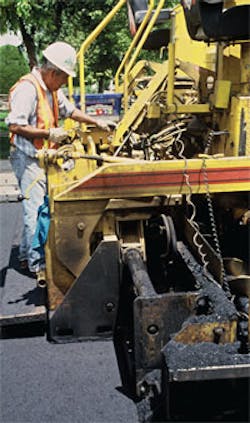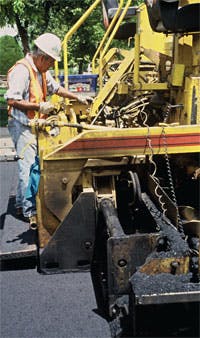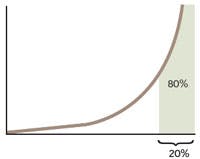We all need to do more with less in the current economic climate, and the key to achieving more with fewer resources is to direct available time and money to activities that deliver the greatest return. Sounds obvious, right? But the fact is most of us aren’t very good at deliberately skewing our allocation of resources to efforts that give us the greatest leverage. That’s because we’ve been conditioned to treat everyone — and by extension, everything— equally for most of our lives.
The truth is, we live in a skewed world. Nothing is evenly distributed. For example, 80% of the wealth is held by 20% of the population. Most likely, 80% of your firm’s sales likely come from 20% of its customers. And 80% of hydraulic equipment breakdowns are due to 20% of the possible causes. This is represented graphically by the skew curve shown in Figure 1.
Get to know Pareto’s Law
You may recognize this as the 80/20 principle, or Pareto’s Law — named after the Italian economist Vilfredo Pareto, who first recognized the pattern in 1897. Pareto was studying the distribution of wealth in England during the 1800s. Perhaps not surprisingly, he soon discovered that a minority of the population held the majority of the wealth . But when he looked further, Pareto also found the distribution of wealth was predictably skewed and consistently so — regardless of which nation or time period he analyzed.
Put simply, Pareto’s Law states an almost universal truth that nothing is uniformly distributed. The comparative split between any two sets of variables may not be 80/20. It could be 95/5, 60/40, or any other variation. But it’s unlikely to be 50/50 — which represents linear, or even, distribution.
Pareto’s Law has since been validated in many business applications. Pareto analysis played a significant role in the quality revolution, with two of its most notable proponents, W. Edwards Deming and Joseph Juran, applying it to identify the 20% of defects causing 80% of the quality problems. In the business world, it’s not unreasonable to expect that if a firm has five sales people, the top salesperson will bring in 80% of the sales — that’s four times the sales of all the others put together.
Bell curve vs. skew curve
Understanding Pareto’s Law can help us identify points of leverage. And the more skewed the distribution, the more powerful the leverage.
In the sales example, the sales manager’s natural inclination is usually to invest time and money improving the results of her underperforming sales people. In other words, she focuses on getting her below average sales people up to the average. This is ‘bell’ curve thinking —see Figure 2.
The principle of unequal effort and return represented by Pareto’s Law means a better outcome (more sales) will be achieved by shifting these resources to assisting her star performer. This is skew curve thinking.
On a more personal level, if you have 10 phone calls to return, the skew curve tells you that one or two of these calls probably warrant your immediate attention, while the other eight can be returned either at your convenience or not at all.
Similarly, in maintenance operations, if 95% of your breakdowns were due to 5% of the possible causes, it follows that if you concentrate your efforts on identifying and eliminating this small percentage of causes, you will eliminate 95% of your breakdowns.
In case you’re thinking this is easier said than done, here’s an example of the practical application of skew curve thinking to hydraulics maintenance.
During a meeting with a new client, I was briefed on their hydraulic hose “maintenance program” for their fleet of hydraulic mining shovels. This involved changing out every hose on the machine every 18 months. So whenever a shovel was down for planned maintenance, a portion of the hoses were replaced — beginning with the oldest first.
The hydraulic hose supplier who devised the program was somewhat of a hero because, prior to its implementation, ad-hoc hose replacement in response to in-service failures had resulted in machine availability falling to as low as 65%. When a multi-million dollar shovel stops, so does a multi-million dollar fleet of haul trucks. So downtime is a major cost. But large diameter, multi-spiral, hydraulic hoses aren’t cheap either.
Although I couldn’t argue with the success of the hose replacement program, I did point out its fundamental flaw. It was treating all hoses equally. The 80/20 principle suggests it would be highly unlikely that 50% of the hoses were responsible for 50% of the in-service failures and downtime.
So I explained to my client if he were to look at the historical data, he should expect to see a skewed picture. That 20% of the hoses were causing 80% of the in-service failures and downtime.
In fact, the available data revealed less than 20% of the hoses were responsible for nearly 90% of the failures (note that we are comparing two sets of unique data, so the comparative split doesn’t have to add up to 100).
Not only did this discovery reduce my client’s hose bill — oils spills, ingression of air and other contaminants, and the risk associated with the introduction of human agents as a result of unnecessary hose replacement were eliminated as well.
Here’s the point: if you’re applying linear thinking to any facet of your business, professional, or personal life, it’s wrong. Apply the law of unequal effort and return. Identify and focus on the 20% of events that contribute to 80% of your success. Little hinges swing big doors.
Brendan Casey has more than 20 years experience in the maintenance, repair, and overhaul of mobile and industrial hydraulic equipment. For information on reducing the operating cost and increasing the uptime of your hydraulic equipment, visit his web site www.hydraulicsupermarket.com or contact him at [email protected].
About the Author

Leaders relevant to this article:



